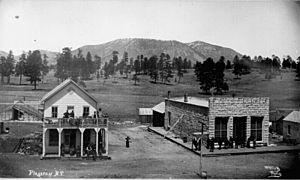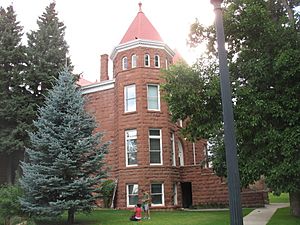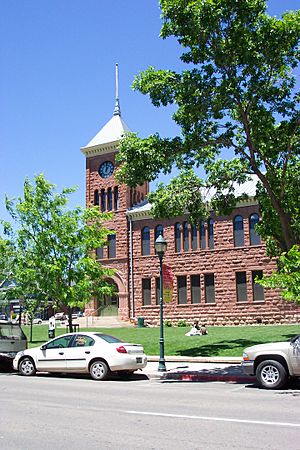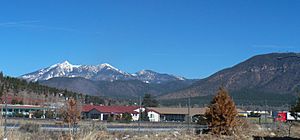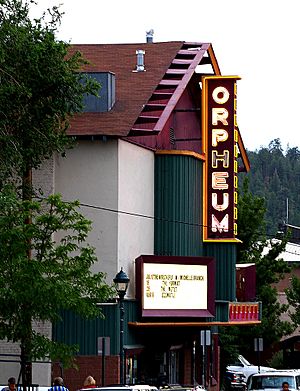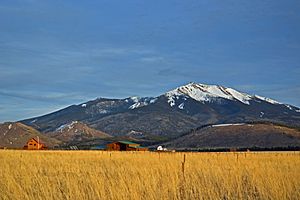Flagstaff, Arizona facts for kids
Quick facts for kids
Flagstaff, Arizona
|
|
|---|---|
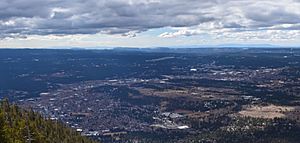
Flagstaff in 2019, as seen from Mount Elden
|
|
| Nicknames:
City of Seven Wonders, Dark Sky City
|
|
| Country | |
| State | |
| County | Coconino |
| Settled | 1876 |
| Incorporated | 1928 |
| Government | |
| • Type | Council–manager |
| • Body | Flagstaff City Council |
| Area | |
| • City | 66.08 sq mi (171.15 km2) |
| • Land | 66.03 sq mi (171.02 km2) |
| • Water | 0.05 sq mi (0.14 km2) |
| Elevation | 6,910 ft (2,106 m) |
| Population
(2020)
|
|
| • City | 76,831 |
| • Density | 1,163.59/sq mi (449.26/km2) |
| • Metro | 139,097 (US: 291st) |
| Demonym(s) | Flagstonian or Flagstaffer or Flagstaffian |
| Time zone | UTC−7 (MST (no DST)) |
| ZIP codes |
86001–86002, 86004–86005, 86011
|
| Area code(s) | 928 |
| FIPS code | 04-23620 |
| GNIS ID(s) | 28749, 29046 |
| Major airport | Flagstaff Pulliam Airport |
| Interstates | |
| U.S. Highways | |
| State Routes | |
Flagstaff is a city in northern Arizona, in the southwestern United States. It is the main city of Coconino County. In 2020, about 76,831 people lived there. The larger Flagstaff area has an estimated population of 139,097.
Flagstaff is located near the edge of the Colorado Plateau. It sits within a volcanic area and next to the largest Ponderosa pine forest in the United States. The city is about 7,000 feet (2,100 meters) above sea level. It is close to Mount Elden and the San Francisco Peaks, which are Arizona's highest mountains. Humphreys Peak, the highest point in Arizona, is just north of Flagstaff.
The land around Flagstaff is fertile because of volcanic ash from eruptions long ago. The city was first settled in 1876. Later, Route 66 passed through Flagstaff, changing its main industry from lumber to tourism. In 1930, the planet Pluto was discovered from an observatory in Flagstaff. The city also helped the Apollo program choose Moon landing sites in the 1960s.
Today, Flagstaff is a hub for companies like Nestlé Purina PetCare. It is also home to the United States Naval Observatory Flagstaff Station and Northern Arizona University. Many tourists visit Flagstaff because it is close to Grand Canyon National Park, Oak Creek Canyon, the Arizona Snowbowl ski resort, and Meteor Crater.
Contents
Flagstaff's History
The name "Flagstaff" comes from a story about early travelers. It is said that surveyors or prospectors stripped a tall pine tree to fly an American flag. Because of this flag, the area became known as Flagstaff.
The first permanent home was built in 1876 by Thomas F. McMillan. In the 1880s, Flagstaff began to grow. It got its first post office and attracted the railroad industry. The early economy was based on timber, sheep, and cattle. By 1886, Flagstaff was the biggest city on the railroad line between Albuquerque and the West Coast.
Discoveries at Lowell Observatory
In 1894, astronomer Percival Lowell chose Flagstaff for a new observatory. He liked its high elevation, which is great for looking at stars. The famous Lowell Observatory was built there. In 1930, the dwarf planet Pluto was discovered using one of its telescopes. Later, in 1955, the United States Naval Observatory Flagstaff Station was built. In 1978, Pluto's moon, Charon, was discovered there.
During the Apollo program in the 1960s, the Lowell Observatory's telescope was used to map the Moon. This helped NASA choose safe landing spots for the lunar missions. Because of Flagstaff's important role in astronomy, an asteroid and an orchestra are named after the city.
Growth and Route 66
The Northern Arizona Normal School, now Northern Arizona University, was started in 1899. The city grew quickly because it was on a busy transcontinental railroad line. Many trains traveled through Flagstaff every day.
Route 66 was finished in 1926 and also passed through Flagstaff. The city became official in 1928. In 1929, the first motel, the Motel Du Beau, was built. Flagstaff became a popular stop on Route 66, especially because it was close to the Grand Canyon.
Downtown Revitalization
Flagstaff grew and did well through the 1960s. But in the 1970s and 1980s, many businesses left the city center. The downtown area became less active. To fix this, the city made a plan in 1987 to bring life back to downtown. They built a new city hall, library, and county building.
In the 1990s, the downtown area was improved. Sidewalks were repaved, and new shops and restaurants opened. On October 24, 2001, Flagstaff was named the world's first "International Dark-Sky City." This means it works to reduce light pollution so people can see the stars better.
Flagstaff's Geography
Flagstaff is located at 35°11′57″N 111°37′52″W. The city covers about 63.9 square miles (165.5 square kilometers). Only a small part of this area is water.
At 7,000 feet (2,100 meters) high, Flagstaff is next to the largest Ponderosa pine forest in North America. The city is on a mountain surrounded by volcanoes, within the Coconino National Forest. Flagstaff is about 130 miles (209 km) north of Phoenix.
City Layout
Downtown Flagstaff is just east of Mars Hill, where Lowell Observatory is located. Streets in downtown are in a grid pattern, running parallel to Route 66 and the Burlington Northern Santa Fe Rail Line. These run east-west through the city.
Milton Road goes south from Route 66, past the Northern Arizona University campus. It connects to Interstate 17 and Interstate 40. Another road, Beulah Boulevard, becomes Arizona State Route 89A and goes through Oak Creek Canyon to Sedona. North of downtown, Fort Valley Road (U.S. 180) leads to the Museum of Northern Arizona, Arizona Snowbowl, and Grand Canyon National Park.
Climate in Flagstaff
Flagstaff has a dry, semi-continental climate. It has five different seasons:
- A cold and snowy winter.
- A dry and windy spring with some snow.
- A very dry and hot early summer.
- A wet and humid monsoon season from July to early September.
- A dry and pleasant fall.
The high elevation and low humidity mean the weather is mild most of the year. Nights are usually much colder than days because the clear air lets heat escape. Winter nights can be very cold, sometimes dropping below 0°F (-18°C).
Flagstaff gets a lot of sunshine, more than many other snowy cities. It is also the only city in Arizona that has never reported temperatures of 100°F (38°C) or higher.
The city gets about 100 inches (254 cm) of snow each year. This makes Flagstaff one of the snowiest cities in the United States. Even with heavy snow, the city has about 277 days a year without much rain or snow.
Arts and Culture
Flagstaff has a lively arts and culture scene. The Flagstaff Symphony Orchestra performs concerts from September to April. The city also hosts several music festivals in the summer. These include folk, bluegrass, and acoustic music events. Popular bands play at the Orpheum Theater, and free concerts are held at Heritage Square.
Flagstaff also has an active theater community. The Northern Arizona University Department of Theatre puts on many plays. Theatrikos Theatre Company, a community theater group, performs five major shows each year. The Flagstaff Light Opera Company performs musical theatre and light opera productions.
Festivals and Traditions
Many weekend festivals happen throughout the year. The Northern Arizona Book Festival brings authors to read their works. The Flagstaff Mountain Film Festival shows independent films about extreme sports and environmental issues. Summer festivals include the Hopi and Navajo Festivals of Arts and Crafts, and the Arizona Highland Celtic Festival.
Every September, Flagstaff hosts the 10-day Flagstaff Festival of Science. This family event has open houses, talks, and hands-on activities at museums, observatories, and the university. The Coconino County Fair is also held in September.
On New Year's Eve, people gather at the Weatherford Hotel to watch a large, metallic pine cone drop from the roof at midnight. This tradition started in 1999.
The Museum of Northern Arizona shows exhibits on the biology, history, and art of the Colorado Plateau. The Arboretum at Flagstaff is a large garden with 2,500 types of plants that can grow in dry areas.
Route 66 greatly increased travel to Flagstaff and helped its culture and tourism. Route 66 is still a historic route through the city. In early September, Flagstaff hosts an annual "Route 66 Days" event to celebrate its connection to the famous highway.
Parks and Outdoor Activities
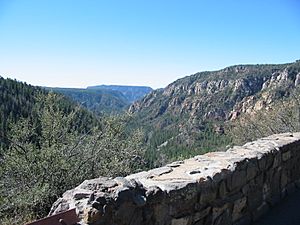
Flagstaff is a popular place for outdoor activities. Its varied landscape, high elevation, and good weather attract campers, hikers, climbers, and bikers. The city has 679.2 acres (275 hectares) of city parks. Thorpe Park and Buffalo Park are the largest. Wheeler Park, near city hall, hosts summer concerts.
The city has a large network of trails called the Flagstaff Urban Trails System, or "FUTS." It has over 50 miles (80 km) of paved and unpaved trails for hiking, running, and cycling. These trails are used for fun and for getting around the city.
The area is a hub for cycling, triathlon events, and cross-country ski races. Many companies that run river trips are based in Flagstaff. The city is a starting point for trips to the Grand Canyon and Colorado River.
Flagstaff is close to Grand Canyon National Park, which is about 75 miles (121 km) north. This has made it a popular tourist spot for a long time. Other nearby outdoor attractions include Walnut Canyon National Monument, Sunset Crater Volcano National Monument, Wupatki National Monument, and Barringer Crater.
Sister Cities
Flagstaff has five sister cities:
|
Flagstaff's Economy
In its early days, Flagstaff's economy was based on lumber, railroads, and ranching. Today, tourism, education, government, and transportation are the main industries. Large employers include Northern Arizona University and the Flagstaff Medical Center. Tourism is very important, with over 5 million visitors each year.
Flagstaff also has scientific and high-tech research centers. These include Lowell Observatory, the United States Naval Observatory Flagstaff Station, and the United States Geological Survey's Flagstaff campus. They study things like asteroids and comets.
The city has five industrial parks. Major manufacturers include W. L. Gore & Associates (known for Gore-Tex), Nestlé Purina PetCare (pet food), and Joy Cone (ice cream cones).
Tourism in Flagstaff
Flagstaff has a strong tourism industry. This is mainly because it is close to Grand Canyon National Park and other natural wonders. This is why it is called the "City of Seven Wonders." Historic Route 66 and its astronomy history also attract visitors. People from southern Arizona visit for its cooler summer climate and its ski resort in winter.
The first stagecoach tours from Flagstaff to the Grand Canyon started in 1892. In 2000, about 5 million people visiting the Grand Canyon also visited Flagstaff. The city has many hotels and restaurants. The first Ramada Inn opened in Flagstaff in 1954.
Lowell Observatory celebrated its 125th anniversary in 2019. It is still a top astronomy research center and a popular place for visitors. Over 100,000 people visited in 2018 and 2019.
The Arizona Snowbowl ski resort is also important for the economy. It supports about 200 full-time jobs.
Sports in Flagstaff
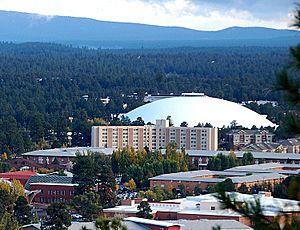
Flagstaff does not have its own professional sports teams. However, it is home to the college sports teams of Northern Arizona University. It is also a popular place for athletes to train, especially because of its high altitude and good climate.
Northern Arizona Lumberjacks
Northern Arizona University has 15 sports teams that compete at the NCAA Division I level. Their football team plays in the Division I Football Championship Subdivision. The NAU football team has a rivalry with the Southern Utah Thunderbirds. This is called the Grand Canyon Rivalry.
Altitude Training Destination
Flagstaff is a popular place for altitude training. Athletes train here to improve their performance because the air has less oxygen at high altitudes. The first elite athletes to train in Flagstaff were preparing for the 1968 Summer Olympics in Mexico City.
Many Olympic medalists from around the world have trained at the HYPO2 altitude training center in Flagstaff. This center was created in 2012. In 2016, the city even advertised with the slogan "The Road to Rio Runs Through Flagstaff." This highlighted that if Flagstaff's training athletes were a country, it would be among the top Olympic-medal winning nations.
Long-distance runners love Flagstaff because of its altitude and pleasant climate. It is known as a "running mecca."
Education in Flagstaff
The Flagstaff Unified School District has 19 public schools with about 11,500 students. In 2012, Flagstaff was named America’s first STEM Community. This means it focuses on science, technology, engineering, and math education.
Besides public schools, there are several charter schools in Flagstaff. These include Flagstaff Junior Academy and Northland Preparatory Academy.
Flagstaff has three colleges:
- Northern Arizona University: One of Arizona's three public state universities.
- Coconino Community College: A local community college.
- Flagstaff College: A small college focused on sustainability and social justice.
Infrastructure
Transportation in Flagstaff
Roads
Flagstaff is connected to other cities by major highways. Interstate 17 (I-17) goes to Phoenix. Interstate 40 (I-40) connects to Los Angeles and Albuquerque. Route 89 goes north to Page and beyond.
The main road through Flagstaff is Route 66/Santa Fe Avenue. It runs parallel to the Burlington Northern Santa Fe (BNSF) Railway line. Milton Road connects Route 66 to the interstates downtown. Arizona State Route 89A connects Flagstaff to Sedona and Prescott. Route 180 goes to the Grand Canyon.
Public Transport
Local bus service is provided by the Mountain Line. Long-distance bus service is available from Greyhound Lines and Flixbus. Shuttle services are also available. Bus service to the Hopi Reservation and Navajo Nation is also provided.
Trains
The main train line through Flagstaff is the Southern Transcon. Amtrak provides passenger train service at the downtown Flagstaff station. You can take the Southwest Chief train to Los Angeles or Albuquerque.
Air Travel
Air travel is available at Flagstaff Pulliam Airport (FLG), just south of the city. It is a small airport. You can fly to Phoenix Sky Harbor International Airport, Dallas-Fort Worth International Airport, and Denver International Airport from here.
Biking
Flagstaff is a good city for bikes. Many major streets have bike lanes. The Flagstaff Urban Trails System (FUTS) has over 50 miles (80 km) of off-street trails. In 2006, Flagstaff was named a Bicycle-Friendly Community. About nine percent of trips in Flagstaff are made by bicycle.
Utilities
Electricity in Flagstaff comes from Arizona Public Service. Drinking water comes from Lake Mary and from wells around the city. Water and wastewater services are provided by the City of Flagstaff. Natural gas is provided by UniSource Energy Services.
Images for kids
See also
 In Spanish: Flagstaff para niños
In Spanish: Flagstaff para niños




